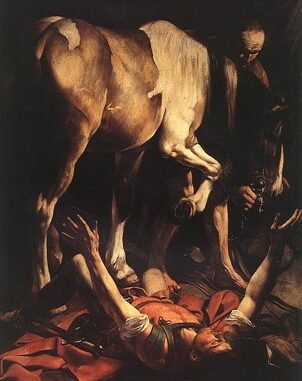
Michelangelo Merisi da Caravaggio spent several years in Rome before fleeing a death warrant in 1606 issued after he had committed murder. He was in Rome when the Catholic church was actively countering Protestantism, building new churches and commissioning new artworks. Whilst he was there he benefited from this policy and executed many works for patrons in the Eternal City. His paintings are worth seeking out to gain an understanding of Tenebrism which he invented – the extreme contrasts of darkness and light which add to the theatricality of his work.
Musei Capitolini
There are two Caravaggios in the Musei Capitolini. The earliest is the Fortune Teller which dates from 1594 before the artist’s mature style had yet developed. It is still an example of Caravaggio eschewing current beliefs in art. Artists were supposed to base their works on ancient statues and images. Instead Caravaggio took his models from the street. The gypsy girl slyly stealing the young man’s ring was indeed a gypsy girl in real life.

The second picture in the Musei is St John the Baptist, again pictured from life, although the model is given a pose from one of Michelangelo’s Ignudos. The image has little to connect it with St John, except for its name label. Caravaggio has painted a Pagan image of a sensual young man rather than the saint that would be expected. The ram is not a symbol of St John, indeed it is often a symbol of lust. Nevertheless the picture was a success.
Santa Maria del Popolo
There are other great works in this Augustine church, but the Cerasi chapel to the left of the altar is the one that holds the two highly prized Caravaggio paintings. It is great to see them still in situ rather than in an art gallery, viewed from sideways on as the artist intended. The dramatic light binds the two pictures together as they face each other over the small space of the chapel, separated by a Carracci Assumption of the Virgin above the altar.

The Crucifixion scene is the more brutal, the Road to Damascus showing an event that would affect Paul positively. Peter asked to be crucified upside down so as not to imitate Jesus. Caravaggio’s paintings for both walls were rejected initially and he had to produce new versions which were accepted and remain in the chapel.

Peter and Paul were the greatest saints in the Catholic church, representing the creation of the church in Rome. As such these paintings would have symbolised the church’s solid position in the counter-reformation, especially important given Santa Maria’s position on the route of Northern pilgrims entering Rome.
Vatican pinacoteca
The pinacoteca is part of the Vatican museums and it is worth making time to visit it as part of any trip to the Sistine chapel. The Entombment of Christ – is a large painting at over 300 x 200 cm. It shows off Caravaggio’s naturalistic realism and tenebrism – his use of dark shadows and brilliant light. Like a waterfall the mourners fall across the picture plane, fingers fluttering like the tips of waves over the dead Christ’s human body.

Read from left to right as Caravaggio intended, the movement takes the viewer from the depths of the ground via Christ to the heavens, an orthodox message that for once meant Caravaggio was not at odds with his patron or fellow artists.

Leave a Reply